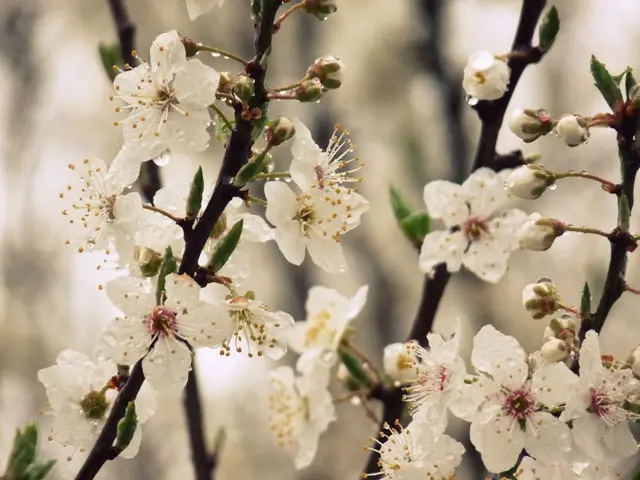Mountaineering cost in Nepal increases for scaling Everest, yet the administration provides 97 summit-less peaks free for two consecutive years.
Nepal Opens 97 Himalayan Peaks for Free Climbing: Infrastructure Boost Aims to Attract Tourists
Nepal is making a bold move to boost tourism and stimulate its economy by making 97 of its Himalayan mountains accessible for free climbing. This initiative, announced in July 2025, covers 77 peaks in the Karnali province and 20 in Sudurpaschim, aiming to attract climbers to these remote, scenic but underdeveloped areas [2][4].
The government's plans to improve infrastructure and connectivity in these provinces are crucial to the success of this initiative. However, challenges remain in addressing connectivity bottlenecks like dangerous river crossings, inadequate road infrastructure, and limited transportation options [1][2][3][5].
Improving transportation and safety is a key focus. Karnali and Sudurpaschim still face serious challenges with unsafe improvised river crossings called tuins (river cable crossings) and limited road access. The Karnali government announced plans to eliminate all tuins this fiscal year by building suspension bridges, but progress is slow due to limited budgets [1].
Road upgrades are also on the agenda. The Karnali Corridor is slated for upgrades to boost connectivity, but many projects suffer from delays and inadequate funding. The federal government allocated minimal funds to key roads like the Darchula-Tinker road in 2025-26, impacting road construction and maintenance [1][5].
Electricity and transmission lines are also being addressed. Large infrastructure contracts worth $154.5 million were signed under the Millennium Challenge Account-Nepal (MCA-Nepal) in August 2025 to improve electricity transmission lines across Nepal, including areas linked to Karnali and Sudurpaschim. These projects aim to strengthen infrastructure and unlock economic growth through better power availability and enhanced transportation networks [3].
Tourism promotion and marketing are also part of the plan. Although most of Nepal’s tourism budget goes to global marketing, there is recognition that without improved infrastructure—roads, bridges, safe crossings, and hospitality facilities—the objective of making these remote peaks accessible and attractive to international climbers will remain difficult [2][4].
Meanwhile, the Nepalese parliament is discussing a new law that will require climbers to have first summited a mountain over 7,000 meters in Nepal before attempting Everest. Last year, climbing fees brought in $5.9 million for Nepal, with over three-quarters for climbing Everest. From September 1, the cost to climb Everest will rise to $15,000 [6].
These provinces are among the poorest in Nepal, and it is hoped that this initiative will create jobs, generate income, and strengthen the local economy [4]. Despite the challenges, the government is attempting to accelerate infrastructure development including suspension bridges and road upgrades, supported by significant investments in electricity transmission, to effectively support the new tourism initiative [1][2][3][5].
References: [1] The Himalayan Times. (2026, March 1). Karnali's Infrastructure Development Delayed. Retrieved from https://thehimalayantimes.com/nepal/karnalis-infrastructure-development-delayed/
[2] The Kathmandu Post. (2025, July 1). Nepal Opens 97 Himalayan Peaks for Free Climbing. Retrieved from https://thekathmandupost.com/nepal/2025/07/01/nepal-opens-97-himalayan-peaks-for-free-climbing
[3] The Himalayan Times. (2025, August 15). MCA-Nepal Signs Contracts Worth $154.5 Million. Retrieved from https://thehimalayantimes.com/business/mca-nepal-signs-contracts-worth-1545-million/
[4] The Himalayan Times. (2025, July 15). Karnali and Sudurpaschim to Benefit from Free Climbing Initiative. Retrieved from https://thehimalayantimes.com/nepal/karnali-and-sudurpaschim-to-benefit-from-free-climbing-initiative/
[5] The Kathmandu Post. (2025, March 1). Road Upgrades Delayed in Karnali. Retrieved from https://thekathmandupost.com/nepal/2025/03/01/road-upgrades-delayed-in-karnali/
[6] The Himalayan Times. (2026, August 1). Everest Climbing Permit Fees to Rise. Retrieved from https://thehimalayantimes.com/nepal/everest-climbing-permit-fees-to-rise/
- The new law in Nepal requires climbers to have previously summited a mountain over 7,000 meters in Nepal before attempting Everest, intending to attract more experienced climbers for adventure-travel and to generate more revenue from the report of successful climbs, which can boost the local lifestyle and economy of the underdeveloped regions.
- As the government continues to address infrastructure challenges such as unsafe improvised river crossings, limited road access, and electricity transmission, the promotion and marketing of these newly accessible Himalayan peaks for travel and adventure-travel activities will attract climbers worldwide, potentially leading to improved lifestyle and economic growth in the Karnali and Sudurpaschim provinces.




